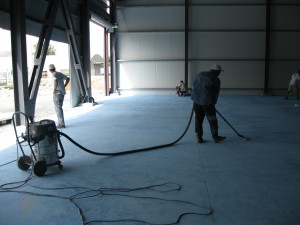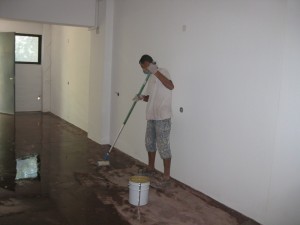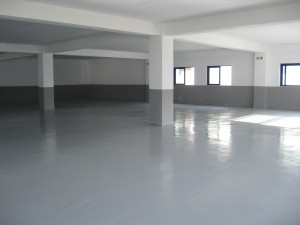Epoxy Floor Coating – 7 Step guide to apply
Preparing the surface
Step 1. Prepare the surface. Preparation of the substrate is necessary in order to ensure adhesion between the epoxy product and the substrate. Suitable methods are sanding or diamond-grinding. Any surfaces that have been contaminated with oils may also require chemical cleaning.

Step 2. Sweeping and cleaning of the floor. Use an industrial vacuum that picks up even small dust particles. The floor must be cleaned of all dusts and residues before starting to prime. Otherwise you will have various particles trapped within the coat and adhesion will be significantly weakened. The less micro-dust on the surface the less primer you will need.

Priming and Filling
Step 3. Prime the floor with a suitable epoxy primer. Always prime the floor, don’t believe claims that priming is not necessary. Priming will give your floor a longer life and better adhesion to the substrate. Furthermore it will seal the substrate thus eliminating the risks of bubbles and gasses. Priming also helps reduce the amount of product that will be required in the later stages. Ensure that the areas are ventilated properly. It is common to coat two layers of primer in order to properly seal the floor. Use a proper electrical mixer to mix the A and B component of the primer.

Step 4. Fill all cracks, holes etc with epoxy grout. (This step can also take place before priming if you prefer) For thin cracks it may be necessary to slice them with a diamond cutter before filling in order to improve the anchoring of the grout.

Applying the epoxy floor coating
Step 5. Application of the first coat of epoxy paint. Empty all the contents of the hardener in the component A. Use an electrical mixer and mix at least for two minutes. Don’t skimp on the mixing! This step is very important. Poor mixing will lead to a tacky floor!

Step 6. Apply the product with a roller. Use a good quality roller, as poor quality rollers may start to shed. You should be able to re-coat after 24 hours. The next day you may notice various problems that have appeared such as cracks, holes etc. Make sure that these are sealed-filled before starting the next coat. You may also need to sand some uneven surfaces that appeared after the first coat. If necessary wait an extra dry for the grout to dry before re-coating.

Step 7 Apply the final coat. Before placing the final coat make sure all holes and cracks have been filled, and that all dust has been collected. Otherwise you will get an ugly texture on the final surface. Remember most epoxy products have a pot life of approximately 40 minutes (or less) so only mix one bucket at a time and get to work immediately.

Source: LEARNCOATINGS © 2017 By

